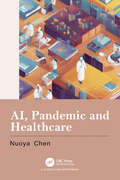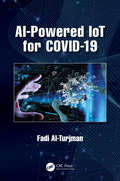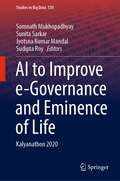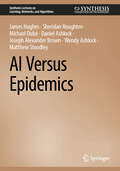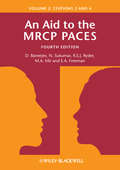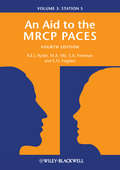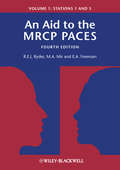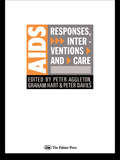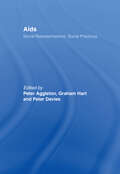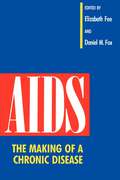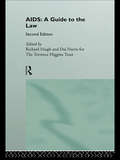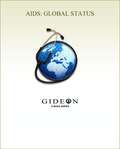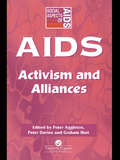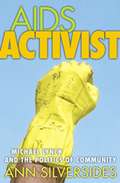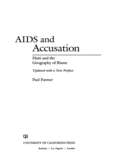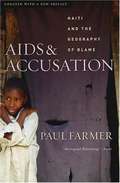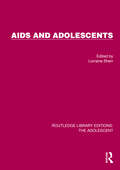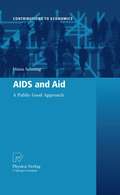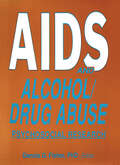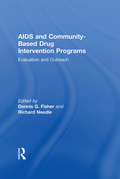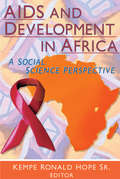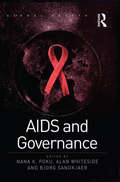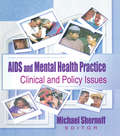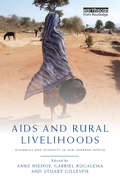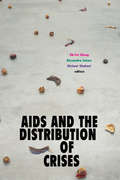- Table View
- List View
AI, Pandemic and Healthcare
by Nuoya ChenThe demand for telehealth solutions has been growing exponentially after the Covid-19 pandemic. Hospitals remain understaffed, which leads to staff burnouts and unsatisfactory patient experience. They also find it difficult to use AI to reduce the workload for doctors and nurses. Doctors barely use data collected from wearables and home-use medical devices to make diagnosis. As generative AI advances, traditional medical device manufacturers are exploring with open innovation to transform into a software-based business model facing competition from large tech companies and startups. This book shares the perspectives from different stakeholders around the challenges of the use of AI in healthcare.
AI-Powered IoT for COVID-19
by Fadi Al-TurjmanThe Internet of Things (IoT) has made revolutionary advances in the utility grid as we know it. Among these advances, intelligent medical services are gaining much interest. The use of Artificial Intelligence (AI) is increasing day after day in fighting one of the most significant viruses, COVID-19. The purpose of this book is to present the detailed recent exploration of AI and IoT in the COVID-19 pandemic and similar applications. The integrated AI and IoT paradigm is widely used in most medical applications, as well as in sectors that deal with transacting data every day. This book can be used by computer science undergraduate and postgraduate students; researchers and practitioners; and city administrators, policy makers, and government regulators. It presents a smart and up-to-date model for COVID-19 and similar applications. Novel architectural and medical use cases in the smart city project are the core aspects of this book. The wide variety of topics it presents offers readers multiple perspectives on a variety of disciplines. Prof. Dr. Fadi Al-Turjman received his PhD in computer science from Queen’s University, Kingston, Ontario, Canada, in 2011. He is a full professor and research center director at Near East University, Nicosia, Cyprus.
AI to Improve e-Governance and Eminence of Life: Kalyanathon 2020 (Studies in Big Data #130)
by Somnath Mukhopadhyay Sunita Sarkar Jyotsna Kumar Mandal Sudipta RoyThe volume presents research works on developing Artificial Intelligence based algorithms and methodologies for making social good that too to a notable one. The book discusses latest findings on efficient technological solutions of e-governance and other areas of life from the leading researchers in the field. The prime focus is on solving socio-economic technical problems using state-of-the-art research findings like fuzzy computing, evolutionary and hybrid frameworks, neuro computing, etc., along with other AI based computation platforms. The topics covered include solution frameworks using Artificial Intelligence based models in application areas like agriculture and rural development, road accident, travel and tourism, solid waste management, rural medical care, crowd sourced election monitoring system, ragging, rape and other abuses, cyber criminals and cyber bullying, disaster management, social good, etc. The book offers a valuable resource for all undergraduate, postgraduate students and researchers interested in exploring solution frameworks for social good problems using artificial intelligence.
AI Versus Epidemics (Synthesis Lectures on Learning, Networks, and Algorithms)
by James Hughes Sheridan Houghten Michael Dubé Daniel Ashlock Joseph Alexander Brown Wendy Ashlock Matthew StoodleyThis book presents algorithms and tools that are designed to model and extract information from personal contact networks, which represent which individuals in a population are physically in contact with one another. The authors developed these tools based on research they conducted during the COVID-19 pandemic, with the goal of improving responses to epidemics in the future. The book provides methods for modelling the transmission of infection across a population. The authors explain how an epidemic model can be used to strategically distribute vaccines and minimize the spread of a virus. The book shows how evolutionary computation, graph compression, and network induction can be utilized to manage issues that arise from an epidemic.
An Aid to the MRCP PACES
by M. Afzal Mir Robert E. Ryder Dev Banerjee E. Anne Freeman N. SukumarThis new edition of An Aid to the MRCP Paces Volume 2: Stations 2 and 4 has been fully revised and updated, and reflects feedback from PACES candidates as to which cases frequently appear in each station.The cases and scenarios have been written in accordance with the latest examining and marking schemes used for the exam providing an invaluable training and revision aid for all MRCP PACES candidates.
An Aid to the MRCP PACES
by Robert E. Ryder Edward Fogden M. Afzal Mir Anne FreemanAn Aid to the MRCP PACES Volume 3: Station 5 is a brand new, fully updated edition of the best-selling PACES revision guide to address the newest Station, covering Integrated Clinical Assessment, with content guided by the experiences of PACES candidates.The cases and scenarios have been written in accordance with the latest examining and marking schemes used for the exam providing an invaluable training and revision aid for all MRCP PACES candidates.In order to fully support candidates taking the exam, this trilogy of best-selling revision aids is now presented as:An Aid to the MRCP PACES Volume 1: Stations 1 and 3, Fourth Edition9780470655092An Aid to the MRCP PACES Volume 2: Stations 2 and 4, Fourth Edition9780470655184An Aid to the MRCP PACES Volume 3: Station 5, Fourth Edition9781118348055
An Aid to the MRCP PACES
by Robert E. Ryder E. Anne Freeman M. Afzal MirThis new edition of An Aid to the MRCP Paces Volume 1: Stations 1 and 3 has been fully revised and updated, and reflects feedback from PACES candidates as to which cases frequently appear in each station.The hundreds of cases have been written in accordance with the latest examining and marking schemes used for the exam and, together with exam hints, tips, routines and clinical checklists, provide an invaluable training and revision aid for all MRCP PACES candidates.
AIDS: Responses, Interventions And Care (Social Aspects of AIDS #Vol. 4)
by Peter Aggleton Graham Hart Peter DaviesFirst published in 1991. Routledge is an imprint of Taylor & Francis, an informa company.
AIDS: Social Representations, Social Practices (Social Aspects of AIDS #Vol. 2)
by Peter Davies Peter Aggleton Graham HartFirst Published in 1989. Routledge is an imprint of Taylor & Francis, an informa company.
AIDS: The Making of a Chronic Disease
by Elizabeth Fee Daniel M. FoxWhen AIDS was first recognized in 1981, most experts believed that it was a plague, a virulent unexpected disease. They thought AIDS, as a plague, would resemble the great epidemics of the past: it would be devastating but would soon subside, perhaps never to return. By the middle 1980s, however, it became increasingly clear that AIDS was a chronic infection, not a classic plague.In this follow-up to AIDS: The Burdens of History, editors Elizabeth Fee and Daniel M. Fox present essays that describe how AIDS has come to be regarded as a chronic disease. Representing diverse fields and professions, the twenty-three contributors to this work use historical methods to analyze politics and public policy, human rights issues, and the changing populations with HIV infection. They examine the federal government's testing of drugs for cancer and HIV, and show how the policy makers' choice of a specific historical model (chronic disease versus plague) affected their decisions. A powerful photo essay reveals the strengths of women from various backgrounds and lifestyles who are coping with HIV. A sensitive account of the complex relationships of the gay community to AIDS is included. Finally, several contributors provide a sampling of international perspectives on the impact of AIDS in other nations.
AIDS: A Guide To The Law
by Richard Haigh Dai HarrisFirst published in 1995. Routledge is an imprint of Taylor & Francis, an informa company.
AIDS: Global Status 2010 edition
by Gideon Informatics Dr Stephen BergerAIDS: Global Status is one in a series of GIDEON ebooks which summarize the status of individual infectious diseases, in every country of the world. Data are based on the GIDEON database (www.gideononline.com) which relies on standard text books, peer-review journals, Health Ministry reports and ProMED, supplemented by an ongoing search of the medical literature. Chapters are arranged alphabetically, by country name. Each section is divided into five subsections. 1. Descriptive epidemiology 2. Summary of clinical features 3. Global status of the disease 4. Status of the disease in a specific country 5. References
AIDS: Activism And Alliances (Social Aspects of AIDS #Vol. 10)
by Peter Aggleton Peter Davies Graham HartFrom the start of the AIDS epidemic there have been calls for greater solidarity between affected groups and communities, and public health services. This can be seen both in the move towards healthy alliances in health service work, and in the demands of AIDS activists worldwide. This text brings together specially selected papers addressing these and related themes given at the Eighth Conference on Social Aspects of AIDS held in London in late 1995. Among the issues examined are profession and policy; the heightened vulnerability of groups such as women and younger gay men; and issues of drug use, disability and HIV prevention.
AIDS Activist: Michael Lynch and the Politics of Community
by Ann SilversidesMichael Lynch, the central figure of this book, was a long-time gay activist and a dynamic force in organizing an early response to the AIDS epidemic. Lynch’s prescient articles in The Body Politic spoke to the gay communities of Toronto, New York, and San Francisco. His organizing efforts meant change and hope. AIDS Activist is a crisp and passionate introduction to a wide range of issues. Focusing on personal stories Silversides furnishes a snap-shot history of how the AIDS crisis unfolded and some of the heroic responses to it. Her emphasis on the politics of the gay community response makes this book unique.
AIDS and Accusation
by Paul FarmerDoes the scientific "theory" that HIV came to North America from Haiti stem from underlying attitudes of racism and ethnocentrism in the United States rather than from hard evidence? Award-winning author and anthropologist-physician Paul Farmer answers with this, the first full-length ethnographic study of AIDS in a poor society. First published in 1992 this new edition has been updated and a new preface added.
AIDS and Accusation: Haiti and the Geography of Blame
by Paul FarmerExposes the racism inherent in the now-discredited supposition that AIDS came to the US via Haiti. (It was the other way around.) Award-winning author Paul Farmer, now working in Rwanda, updates this 1992 study with a new preface.
AIDS and Adolescents (Routledge Library Editions: The Adolescent)
by Lorraine SherrOriginally published in 1997, Aids and Adolescents provided an insight into a wide range of adolescent issues which were rarely compiled in one volume at the time. Much of the HIV epidemic response had been at the individual level in the hope that this narrow focus would provide the key to containment and resolution of spread. However, over the ten years since the epidemic had taken hold, it was clear that paradigms were limited, input was uncritical and large cohorts were overlooked. In this text a series of contributions have been compiled to explore adolescent issues ranging from sexual behaviour and health education campaigns to HIV prevention and HIV/AIDS care. The chapters begin by giving an overview of adolescent problems, such as homelessness, pregnancy and gender, and explore why these problems are so often overlooked. We then move on to an examination of the facts and fictions associated with adolescent risk, challenging some of the basic current notions underpinning approaches to the subject at the time. Also included are particular focused studies of Australian adolescents’ beliefs about HIV and STDs and also the American adolescents’ perceptions of drug injection. Finally, the volume gives a focused view of those with HIV infection, with a review of findings of the time, neuropsychological and psychological factors. This overview provided some comments on merging issues and future directions. Today it can be read in its historical context.
AIDS and Aid: A Public Good Approach (Contributions to Economics)
by Diana SonntagThe emerging outlook on the AIDS crisis is bleak; it seems that Millennium Development Goal 6 cannot be achieved in most developing countries by 2015. While most books look at the HIV/AIDS epidemic from an epidemiological point of view, this work evaluates AIDS and the international financing mechanisms of aid from a public good perspective. In contrast to the standard approach of the academic literature on AIDS, which derives policy recommendations from the demand side, this book explicitly considers the supply side. The study does not only advance the public goods literature, it also provides new insights into the effectiveness of international policies and paves the way for policy recommendations. As it reveals the weaknesses of current anti-HIV policies, a more effective allocation of international assistance is postulated.
AIDS and Alcohol/Drug Abuse: Psychosocial Research
by Dennis FisherAIDS is the number one health issue facing the nation today. The way in which AIDS relates to substance abuse is explored by drug abuse researchers in this timely volume. A major focus of AIDS and Alcohol/Drug Abuse is on the problems of conducting AIDS research on racial minorities in this country. Bringing together experts in the field, this volume examines the specific obstacles and challenges researchers have faced in assessing and addressing the needs of underserved populations and maps routes and procedures that can improve both research and available health care services.This unique volume also focuses on aspects of HIV infection that have received little attention elsewhere. It includes the first information published in the open literature about intravenous drug use in Alaska. Another chapter highlights some little-known facts that relate substance abuse to HIV infection in the American Indian/Alaskan Native population, among whom--it has been predicted--a devastating epidemic of HIV infection is likely. Problems with prevention, research, and treatment of individuals who are both intravenous drug users and who are infected with HIV are explored. Other chapters look at the transmission of HIV infection--by gay men who are alcoholics and by intravenous drug users. AIDS and Alcohol/Drug Abuse ends with hopeful chapter for AIDS prevention. Readers interested in the relationship of intravenous drug use and HIV infection, particularly among racial and ethnic minorities, will find this to be a practical, readable book. In particular, substance abuse counselors and researchers, and anyone involved in the AIDS prevention movement will find a valuable wealth of information.
AIDS and Community-Based Drug Intervention Programs: Evaluation and Outreach
by Dennis Fisher Richard NeedleDelve into the uncharted territory of the “hidden” drug addict--users who are not in treatment, not incarcerated, and not officially accessible for research purposes through traditional means. AIDS and Community-Based Drug Intervention Programs describes short-term interventions used to reduce the odds that these drug users will get infected by the Human Immunodeficiency Virus (HIV). The book explains new methods that are being developed, such as targeted sampling, social network analysis, geomapping, and other amalgams of both quantitative and qualitative approaches, that need to be forged to overcome the challenges of the war against AIDS. The research described in this important book was conducted under the Cooperative Agreement for AIDS Community-Based Outreach/Intervention Research funding mechanism of the National Institute on Drug Abuse (NIDA). Chapters include research on several ethnic groups, including Alaska natives, Puerto Ricans, and Navaho teens. AIDS and Community-Based Drug Treatment Programs, written by experts in the field, is a broad-based treatment of the subject by those who are actually doing the work in the trenches. Authors cover topics such as: the use of goal-oriented counseling and peer support to reduce HIV/AIDS risk quantitative and qualitative methods to assess behavioral change among injection drug users (IDUs) the importance of sampling from hidden populations in research a public health model for reducing AIDS-related risk behavior among IDUs and their sexual partners characteristics of female sexual partners of IDUs strategies used to implement random sampling strategies in the recruitment of out-of-treatment crack and IDUs ethnographic analysis of intravenous drug use analysis of contact tracing strategies employed to combat the AIDS epidemic the use of pile sorts to enhance other tools used by drug prevention programsAIDS and Community-Based Drug Intervention Programs is full of current research and useful information for professionals interested in learning about strategies for conducting HIV/AIDS research among hard-to-reach populations. Substance abuse researchers, treatment professionals, and people involved in AIDS prevention programs, state and county health departments, and criminal justice systems will find much relevant and important information to use in their daily work.
AIDS and Development in Africa: A Social Science Perspective (Haworth Psychosocial Issues Of Hiv/aids Ser.)
by R Dennis Shelby Kempe Ronald Hope, SrAIDS and Development in Africa: A Social Science Perspective is the first book-length treatment of both the impact of AIDS in Africa and an assessment of intervention strategies in varying cultural situations. Developed from revised selected papers from the nineteenth Southern African Universities Social Science Conference, AIDS and Development in Africa will be of interest to counselors, medical and development practitioners, Africanists, and AIDS researchers. From this book, you will find wide analytical coverage of the issues and country case studies related to the contributory factors and development impact of the HIV/AIDS pandemic in Africa. You will also explore the ability of countries to willingly promote and cope with the pandemic in the context of their different economic circumstances.Specifically in AIDS and Development in Africa, you will read about: socioeconomic context of AIDS social scientific explanations of the AIDS pandemic in Africa HIV/AIDS and the status of women in Botswana and Swaziland sexual abuse and HIV/AIDS law and HIV/AIDS orphans of the AIDS pandemic media and the African context of social construction human resource development and training in relation to HIV/AIDS in ZambiaAIDS and Development in Africa uses a multidisciplinary social science perspective in case studies of such countries as Botswana, Swaziland, Zimbabwe, South Africa, Malawi, and Zambia to reveal contributory factors and the developmental impact of HIV/AIDS in Africa. This book demonstrates the human consequences of AIDS and the efforts being made by governments, individuals, families, villages, communities, and national government organizations to respond to the pandemic. For example, you will learn about information campaigns and peer education approaches that are successfully increasing transmission awareness and condom use. You will read beyond the usual analysis of demographics and receive much more substantial assessments and analyses of the burden on people, economies, and health care systems of the African countries. AIDS and Development in Africa is indispensable to anyone who is involved with HIV/AIDS prevention/intervention in Africa. This comprehensive book provides you with essential and up-to-date research on the many issues surrounding Africa’s HIV/AIDS pandemic.
AIDS and Governance: Hiv/aids (Global Health)
by Alan WhitesideThe political impact of HIV/AIDS varies greatly and is difficult to map. States depend on how governments choose to manage the political implications of HIV and AIDS, both those stemming from the erosions of its own capacity as well as those that originate from their changing relationship on a national and international level. Across the developing world, HIV/AIDS is slowly killing adults in their most productive years, hollowing out state structures, deepening poverty and raising profound questions that touch on the organization of all aspects of social, economic and political life. With the epidemic showing scant signs of slowing down, this innovative volume assesses how HIV/AIDS affects governance and, conversely, how governance affects the course of the epidemic. In particular, the volume:
AIDS and Mental Health Practice: Clinical and Policy Issues
by R Dennis Shelby Michael ShernoffAddressing contemporary issues faced by individuals with HIV/AIDS, AIDS and Mental Health Practice: Clinical and Policy Issues provides psychologists, psychiatrists, social workers, and counselors with research and case studies that offers models for effective clinical practice at this stage of the epidemic. Each chapter is written by experts in the field and demonstrates ways to provide better services to different populations, many of whom are ignored in AIDS and mental health literature. As a result, this book will provide professionals in the field and students in training with the most current practice information about mental health practice and HIV/AIDS. AIDS and Mental Health Practice will help you understand the diverse needs of people with HIV/AIDS and organize services to assist these populations. AIDS and Mental Health Practice discusses issues that affect several different groups in order to help you understand the unique situations of your clients. You will learn how to design treatments that will be most beneficial to Latinos, intravenous drug users, orphaned children, African Americans, HIV-negative gay men, HIV nonprogressors, HIV-positive transsexuals, end-stage AIDS clients, couples of mixed HIV status, and individuals suffering from HIV-associated Cognitive Motor Disorder. This book provides you with approaches that will improve services for these populations, including: talking to patients about the positive and negative aspects of taking protease inhibitors and discussing their feelings of hope, skepticism, and fear of being disappointed by the treatment preparing clients to go back to work by exploring the meaning of work and referring them to vocational services if necessary providing support groups for people living with AIDS (PLWAs), their loved ones, their families, and individuals in bereavement as a result of an AIDS-related death organizing a HIV-negative gay men’s support group that uses exercises and homework to focus on the members’ambivalent connection to the AIDS community, how they remain HIV negative, and ways to deal with separation and grief issues assessing and/or correcting underlying racism in AIDS service organizationsThe prevention and intervention strategies in Mental Health and AIDS Practice will help you address and treat mental health issues associated with HIV/AIDS and offer clients more effective and relevant services.
AIDS and Rural Livelihoods: Dynamics and Diversity in sub-Saharan Africa
by Anke Niehof Gabriel RugalemaAIDS epidemics continue to threaten the livelihoods of millions of people in sub-Saharan Africa. Three decades after the disease was first recognized, the annual death toll from AIDS exceeds that from wars, famine and floods combined. Yet despite millions of dollars of aid and research, there has previously been little detailed on-the-ground analysis of the multifaceted impacts on rural people. Filling that gap, this book brings together recent evidence of AIDS impacts on rural households, livelihoods, and agricultural practice in sub-Saharan Africa. There is particular emphasis on the role of women in affected households, and on the situation of children. The book is unique in presenting micro-level information collected by original empirical research in a range of African countries, and showing how well-grounded conclusions on trends, impacts and local responses can be applied to the design of HIV-responsive policies and programmes. AIDS impacts are more diverse than we previously thought, and local responses more varied - sometimes innovative, sometimes desperate. The book represents a major contribution to our understanding of the impacts of AIDS in the epidemic's heartland, and how these can be managed at different levels.
AIDS and the Distribution of Crises
by Jih-Fei Cheng Alexandra Juhasz Nishant ShahaniAIDS and the Distribution of Crises engages with the AIDS pandemic as a network of varied historical, overlapping, and ongoing crises born of global capitalism and colonial, racialized, gendered, and sexual violence. Drawing on their investments in activism, media, anticolonialism, feminism, and queer and trans of color critiques, the scholars, activists, and artists in this volume outline how the neoliberal logic of “crisis” structures how AIDS is aesthetically, institutionally, and politically reproduced and experienced. Among other topics, the authors examine the writing of the history of AIDS; settler colonial narratives and laws impacting risk in Indigenous communities; the early internet regulation of both content and online AIDS activism; the Black gendered and sexual politics of pleasure, desire, and (in)visibility; and how persistent attention to white men has shaped AIDS as intrinsic to multiple, unremarkable crises among people of color and in the Global South.Contributors. Cecilia Aldarondo, Pablo Alvarez, Marlon M. Bailey, Emily Bass, Darius Bost, Ian Bradley-Perrin, Jih-Fei Cheng, Bishnupriya Ghosh, Roger Hallas, Pato Hebert, Jim Hubbard, Andrew J. Jolivette, Julia S. Jordan-Zachery, Alexandra Juhasz, Dredge Byung'chu Kang-Nguyễn, Theodore (Ted) Kerr, Catherine Yuk-ping Lo, Cait McKinney, Viviane Namaste, Elton Naswood, Cindy Patton, Margaret Rhee, Juana María Rodríguez, Sarah Schulman, Nishant Shahani, C. Riley Snorton, Eric A. Stanley, Jessica Whitbread, Quito Ziegler
